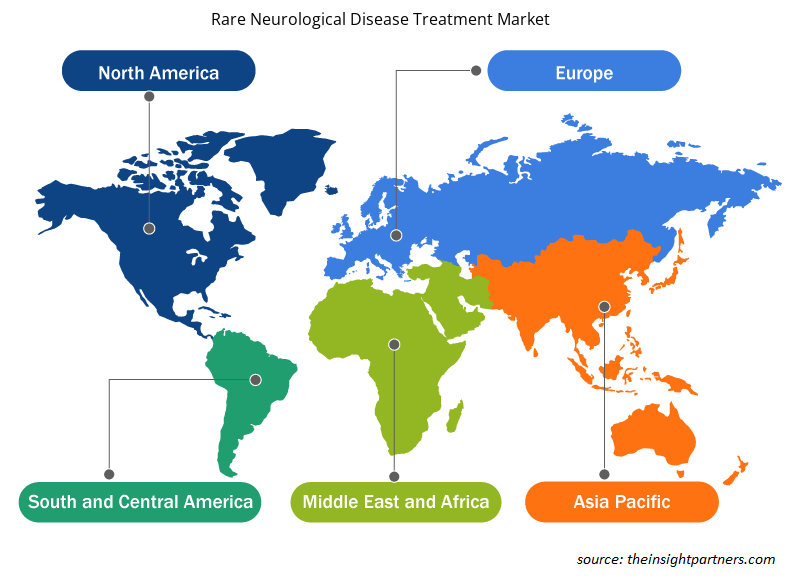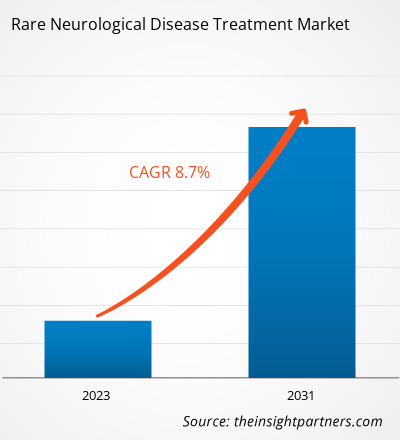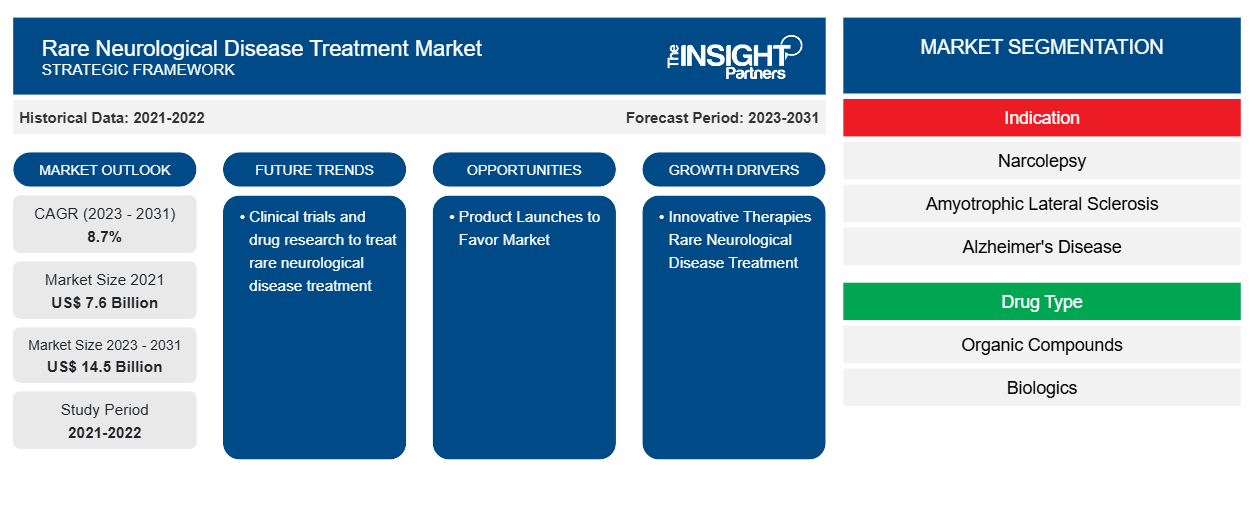Il mercato del trattamento delle malattie neurologiche rare è stato valutato a 7,6 miliardi di dollari nel 2021 e si prevede che raggiungerà i 14,5 miliardi di dollari entro il 2031. Si prevede che il mercato registrerà un CAGR dell'8,7% dal 2023 al 2031. È probabile che le sperimentazioni cliniche e la ricerca sui farmaci per il trattamento delle malattie neurologiche rare rimangano tendenze chiave del mercato del trattamento delle malattie neurologiche rare.
Analisi di mercato per il trattamento delle malattie neurologiche rare
Terapie innovative Trattamento delle malattie neurologiche rare
Il Centre for Drug Evaluation and Research (CDER) ha annunciato nel 2023 l'approvazione per la prima terapia enzimatica sostitutiva per trattare gli effetti non neurologici dell'alfa-mannosidosi (una rara malattia genetica da accumulo lisosomiale). Inoltre, nel marzo 2024, uno studio clinico ha scoperto che una terapia genica sperimentale può aiutare i pazienti con una rara malattia neurodegenerativa. Inoltre, nel maggio 2022, è stato istituito il programma Accelerating Rare Disease Cures (ARC) per guidare l'innovazione scientifica e normativa e l'impegno per accelerare la disponibilità del trattamento per i pazienti con malattie rare. La FDA sfrutterà l'infrastruttura, l'esperienza e la leadership strategica del programma ARC per istituire una task force intercentrica sulle malattie neurodegenerative rare. I fattori sopra menzionati sono responsabili dell'influente crescita del mercato del trattamento delle malattie neurologiche rare nel periodo 2021-2031.
Panoramica del mercato del trattamento delle malattie neurologiche rare
Tecnologia, innovazione e soluzioni tecnologiche intelligenti come continuano a influenzare in modo significativo il mercato del trattamento delle malattie neurologiche rare. Le terapie innovative, il trattamento delle malattie neurologiche rare e i lanci di prodotti sono i fattori più influenti responsabili della crescita del mercato del trattamento delle malattie neurologiche rare. Gli studi clinici e la ricerca sui farmaci per il trattamento delle malattie neurologiche rare sono una tendenza chiave per la crescita del mercato del trattamento delle malattie neurologiche rare. Le crescenti attività di ricerca e sviluppo (R&S) forniranno opportunità di mercato redditizie.
Personalizza questo report in base alle tue esigenze
Riceverai la personalizzazione gratuita di qualsiasi report, comprese parti di questo report, o analisi a livello nazionale, pacchetto dati Excel, oltre a usufruire di grandi offerte e sconti per start-up e università
-
Scopri le principali tendenze di mercato in questo rapporto.Questo campione GRATUITO includerà analisi di dati che spaziano dalle tendenze di mercato alle stime e alle previsioni.
Trattamento delle malattie neurologiche rareFattori di mercato e opportunità
Lancio di prodotti per favorire il mercato
A novembre 2022, CENTOGENE ha annunciato il lancio di "Biodata Network", un portafoglio di malattie rare e neurodegenerative basate sui dati per istituti biofarmaceutici e di ricerca. Inoltre, i set di dati CENTOGENE rappresentano un aumento stimato del 20% sia in ampiezza che in profondità dei dati genomici attualmente disponibili tramite le piattaforme BC. Questo set di dati riflette una base di campioni geografica ed etnica diversificata, inclusa la prevalenza di casi pediatrici affetti da malattie rare e neurodegenerative, inclusi dati clinici, multiomici e sociodemografici. Pertanto, tali set di dati di lancio di prodotti innovativi per il trattamento di malattie neurologiche rare contribuiranno in modo significativo nei prossimi anni.
Attività di ricerca e sviluppo (R&S) in crescita: un’opportunità
- Nel dicembre 2023, la Food and Drug Administration (FDA) ha annunciato sovvenzioni e contratti con enti pubblici e privati per coprire i costi di ricerca e sviluppo (R&S) per prevenire, diagnosticare, attenuare, trattare e guarire la sclerosi laterale amiotrofica (SLA) e altre malattie neurodegenerative comuni negli adulti e nei bambini.
- A giugno 2023, Ipsen e Medentia hanno annunciato una collaborazione per un'ampia scoperta di farmaci e chimica medicinale. Attraverso questa collaborazione, le aziende porteranno collettivamente nuove soluzioni alle persone in tutto il mondo, concentrandosi sulle malattie rare, tra cui le malattie neurodegenerative rare.
Pertanto, le crescenti attività di ricerca e sviluppo offriranno opportunità di mercato redditizie, che rappresenteranno una quota di mercato considerevole nei prossimi anni per il mercato del trattamento delle malattie neurologiche rare.
Trattamento delle malattie neurologiche rare
Analisi della segmentazione del rapporto di mercato
I segmenti chiave che hanno contribuito alla derivazione dell'analisi di mercato del trattamento delle malattie neurologiche rare sono la candidatura e i servizi.
- In base all'indicazione, il mercato del trattamento delle malattie neurologiche rare è segmentato in narcolessia, sclerosi laterale amiotrofica, malattia di Alzheimer, sclerosi multipla, atrofia muscolare spinale, distrofia muscolare di Duchenne e altri. La malattia di Alzheimer potrebbe detenere una quota di mercato maggiore nel 2023.
- In base al tipo di farmaco, il mercato del trattamento delle malattie neurologiche rare è diviso in composti organici e biologici. I biologici potrebbero detenere una quota di mercato maggiore nel 2023.
- In base alla modalità di somministrazione, il mercato del trattamento delle malattie neurologiche rare è diviso in orale e iniettabile. Il segmento orale potrebbe detenere una quota di mercato maggiore nel 2023.
- In base al canale di distribuzione, il mercato del trattamento delle malattie neurologiche rare è segmentato in farmacie ospedaliere, farmacie al dettaglio e altre. Il segmento delle farmacie ospedaliere potrebbe detenere una quota di mercato maggiore nel 2023.
Analisi della quota di mercato del trattamento delle malattie neurologiche rare per area geografica
L'ambito geografico del rapporto Rare Neurological Disease Treatment Market è suddiviso principalmente in cinque regioni: Nord America, Asia Pacifico, Europa, Medio Oriente e Africa e Sud America/Sud e Centro America.
Il Nord America ha dominato il mercato del trattamento delle malattie neurologiche rare. In Nord America, gli Stati Uniti rappresentano una quota considerevole per il trattamento delle malattie neurologiche rare. La presenza di produttori leader negli Stati Uniti e le crescenti attività di R&S sono i fattori più influenti responsabili della crescita del mercato. Si prevede che l'Asia Pacifica crescerà con il CAGR più elevato nei prossimi anni.
Trattamento delle malattie neurologiche rare
Approfondimenti regionali sul mercato del trattamento delle malattie neurologiche rare
Le tendenze regionali e i fattori che influenzano il mercato del trattamento delle malattie neurologiche rare durante il periodo di previsione sono stati ampiamente spiegati dagli analisti di Insight Partners. Questa sezione discute anche i segmenti e la geografia del mercato del trattamento delle malattie neurologiche rare in Nord America, Europa, Asia Pacifico, Medio Oriente e Africa e America meridionale e centrale.

- Ottieni i dati specifici regionali per il mercato del trattamento delle malattie neurologiche rare
Ambito del rapporto di mercato sul trattamento delle malattie neurologiche rare
| Attributo del report | Dettagli |
|---|---|
| Dimensioni del mercato nel 2021 | 7,6 miliardi di dollari USA |
| Dimensioni del mercato entro il 2031 | 14,5 miliardi di dollari USA |
| CAGR globale (2023-2031) | 8,7% |
| Dati storici | 2021-2022 |
| Periodo di previsione | 2023-2031 |
| Segmenti coperti |
Su indicazione
|
| Regioni e Paesi coperti |
America del Nord
|
| Leader di mercato e profili aziendali chiave |
|
Densità degli operatori del mercato del trattamento delle malattie neurologiche rare: comprendere il suo impatto sulle dinamiche aziendali
Il mercato del trattamento delle malattie neurologiche rare sta crescendo rapidamente, spinto dalla crescente domanda degli utenti finali dovuta a fattori quali l'evoluzione delle preferenze dei consumatori, i progressi tecnologici e una maggiore consapevolezza dei benefici del prodotto. Con l'aumento della domanda, le aziende stanno ampliando le loro offerte, innovando per soddisfare le esigenze dei consumatori e capitalizzando sulle tendenze emergenti, il che alimenta ulteriormente la crescita del mercato.
La densità degli operatori di mercato si riferisce alla distribuzione di aziende o società che operano in un particolare mercato o settore. Indica quanti concorrenti (operatori di mercato) sono presenti in un dato spazio di mercato in relazione alle sue dimensioni o al valore di mercato totale.
Le principali aziende che operano nel mercato del trattamento delle malattie neurologiche rare sono:
- Allergan (AbbVie) Inc.,
- La Bayer AG,
- Società per azioni GlaxoSmithKline
- Servizi Johnson & Johnson, Inc.,
- Merck & Co., Inc.,
- Novartis,
Disclaimer : le aziende elencate sopra non sono classificate secondo un ordine particolare.

- Ottieni la panoramica dei principali attori chiave del mercato del trattamento delle malattie neurologiche rare
Malattie neurologiche rare: notizie di mercato e sviluppi recenti
Il mercato del trattamento delle malattie neurologiche rare viene valutato raccogliendo dati qualitativi e quantitativi dopo la ricerca primaria e secondaria, che include importanti pubblicazioni aziendali, dati di associazioni e database. Di seguito è riportato un elenco degli sviluppi nel mercato per il trattamento delle malattie neurologiche rare e delle strategie:
- Nel settembre 2022, la Food and Drug Administration (USFDA) e il National Institute of Health (NIH) degli Stati Uniti hanno annunciato il lancio del "Critical Path for Rare Neurodegenerative Diseases (CP-RND)", una partnership pubblico-privata volta a promuovere la comprensione delle malattie neurodegenerative che favoriscono lo sviluppo di trattamenti per la sclerosi amiotrofica laterale (SLA) e altre malattie neurodegenerative rare.
Copertura e risultati del rapporto di mercato sul trattamento delle malattie neurologiche rare
Il rapporto "Dimensioni e previsioni del mercato del trattamento delle malattie neurologiche rare (2021-2031)" fornisce un'analisi dettagliata del mercato che copre le seguenti aree:
- Dimensioni e previsioni del mercato a livello globale, regionale e nazionale per tutti i segmenti di mercato chiave coperti dall'ambito
- Dinamiche di mercato come fattori trainanti, vincoli e opportunità chiave
- Principali tendenze future
- Analisi dettagliata delle cinque forze PEST/Porter e SWOT
- Analisi di mercato globale e regionale che copre le principali tendenze di mercato, i principali attori, le normative e gli sviluppi recenti del mercato
- Analisi del panorama industriale e della concorrenza che copre la concentrazione del mercato, l'analisi della mappa di calore, i principali attori e gli sviluppi recenti
- Profili aziendali dettagliati
- Analisi storica (2 anni), anno base, previsione (7 anni) con CAGR
- Analisi PEST e SWOT
- Valore/volume delle dimensioni del mercato - Globale, Regionale, Nazionale
- Industria e panorama competitivo
- Set di dati Excel
Report recenti
Testimonianze
Motivo dell'acquisto
- Processo decisionale informato
- Comprensione delle dinamiche di mercato
- Analisi competitiva
- Analisi dei clienti
- Previsioni di mercato
- Mitigazione del rischio
- Pianificazione strategica
- Giustificazione degli investimenti
- Identificazione dei mercati emergenti
- Miglioramento delle strategie di marketing
- Aumento dell'efficienza operativa
- Allineamento alle tendenze normative























 Ottieni un campione gratuito per - Mercato del trattamento delle malattie neurologiche rare
Ottieni un campione gratuito per - Mercato del trattamento delle malattie neurologiche rare